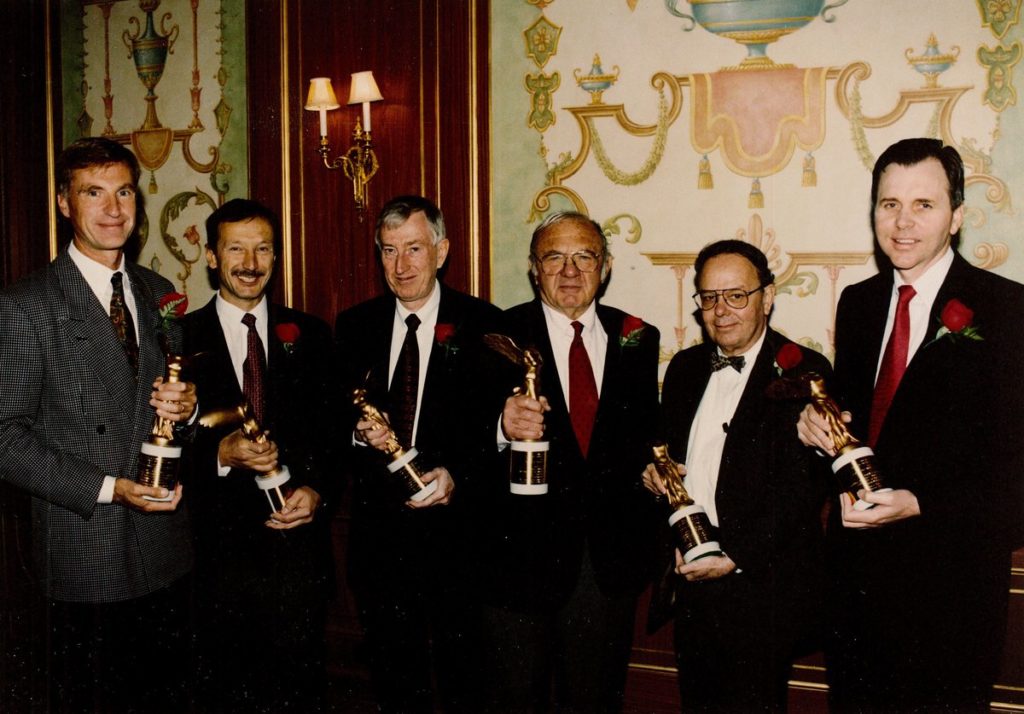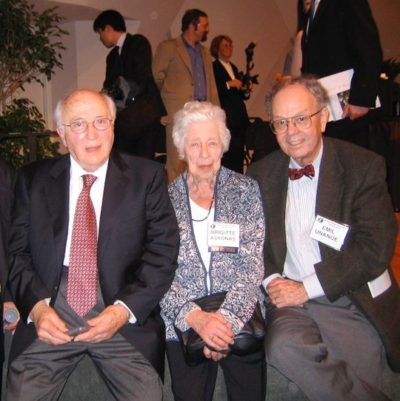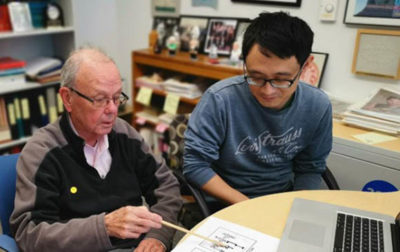For Emil Unanue, a major transformation started with a simple trip to the airport. Unanue was finishing his research fellowship at the Scripps Research Institute in California in the 1960s and hoping to transition into cellular immunology when his mentor suggested he give John Humphrey, head of one of the preeminent groups in the field in England, a ride back to the airport after visiting Scripps. During that brief exchange, Humphrey offered him a research position and Unanue, without knowing it, was on the brink of groundbreaking discoveries about the key role of macrophages in immune responses.

Unanue credits his success in describing the role of macrophages in the adaptive immune response to his persistence and not wanting to “let go” until he could explain his early exciting data.
When Unanue landed in Humphrey’s group at the UK National Institute for Medical Research in London in the late 1960s with his wife and their first child in tow, there was much to be learned about lymphocytes, the cells responsible for the adaptive immune response. The field was nascent and few were studying how lymphocytes circulating in the body encounter antigens, or foreign molecules recognized by the immune system.
But Humphrey had a hunch that macrophages, the fast-acting immune cells that at that time were only known to degrade proteins and kill some pathogenic bacteria, were somehow involved. Unanue, working with his advisor Brigitte ‘Ita’ Askonas, ran with the idea and showed that macrophages seemed to be relaying a message to lymphocytes to mount an adaptive immune response. They could take macrophages from mice and expose them to a protein, then inject the macrophages into other mice and elicit antibodies to the protein.
Upon his return to the United States, Unanue went on to show that macrophages process protein antigens into small fragments called peptides and present them on their surface, bound to molecules encoded by the major histocompatibility complex (MHC). The processed peptides complexed to MHC molecules interact with and primed T cells. These findings explained the fundamental interactions between the T cells and the cells of the phagocytic system, including macrophages. Subsequent studies led by Don Wiley and Jack Strominger at Harvard University resolved the crystal structure of a peptide-MHC complex. Later, Ralph Steinman identified a different set of phagocytes, dendritic cells, that also play a prominent role in antigen presentation. Unanue received the 1995 Albert Lasker Basic Medical Research Award, along with Peter Doherty, Jack Strominger, Don Wiley, and Rolf Zinkernagel, for work describing how T cells, central players in acquired protective immunity, recognize antigens. Steinman received a Lasker Award in 2007.

Left to right: Don Wiley, Rolf Zinkernagel, Peter Doherty, Jack Strominger, Emil Unanue, and Barry Marshall at the 1995 Lasker Awards ceremony
Not Letting Go
Unanue is quick to emphasize that it was his scientific perseverance more than his insight that led to his important discoveries, at least in the early days. Other scientists were arriving at similar findings that macrophages might be stimulating T cells, but they moved on to other research questions. “The merit that I had is that I continued with it and did not let go until there was an explanation for what was going on,” Unanue says. “It gave me a niche, too, because no one was thinking about it,” he adds.
When Unanue returned to Scripps after finishing his two-year fellowship in London, he found that he was the lone researcher among his colleagues there studying macrophages. A major emphasis at Scripps at that time was on immunopathology, how immune reactions cause disease. But fortunately for the field of immunology, Unanue kept at it, and before long, another scientist visiting Scripps changed again the course of his career.
Finding Connections
Unanue grew up in Cuba and was poised to follow in the footsteps of his father, who was a doctor and ran a clinical lab. He enjoyed the part-time job in his dad’s lab, analyzing blood tests for patients with sickle cell anemia, leukemia, and other conditions. But as Unanue was working toward his medical degree at the University of Havana in the late 1950s, the Cuban Revolution was simmering; he had to take a break from his studies because the school closed temporarily. “It was a mess, and I decided I’m not staying here,” Unanue recalls. Moving to the United States, first as a pathology intern at the Presbyterian University Hospital in Pittsburgh, paved the way for Unanue to do basic science research, which he says was less advanced in Cuba.
Almost a decade later, his Cuban roots helped him spark a connection with Baruj Benacerraf, who was visiting Scripps to give a talk. Unanue realized that Benacerraf was a fellow Latino—from Venezuela—and the two hit it off, chatting in Spanish. Benacerraf also made important contributions to understanding the role of MHC in normal immune responses. (MHC was initially discovered because the gene locus was responsible for graft rejection following transplantation.)

Baruj Benacerraf (left) hit it off with Unanue during his visit to Scripps Clinic and Research Foundation in the late 1960s and recruited Unanue to the Department of Pathology at Harvard Medical School where he was chair. Unanue calls this memory from 1976, when he and Benacerraf were both wearing braces because of neck strain, “priceless”.
The encounter was as fateful for Unanue as was the trip to the airport with Humphrey: Benacerraf had just become chair of pathology at Harvard Medical School, with the mission of building up its immunology research, and he went on to recruit Unanue to start an assistant professorship there in 1970.
In a flurry of findings over the next 15 years, Unanue’s team at Harvard detailed how macrophages present antigens to T cells, first working with listeria bacteria to show how macrophages internalize pathogens, and then with a well-studied antigenic protein to map out how the protein directly interacts with MHC and which peptides are recognized by T cells. His rapid progress did not, however, protect him from criticism. The studies on antigen processing were new, and the dogma in immunology for many years had been that proteins were recognized prior to degradation by the immune system. But as studies by Unanue and others advanced, it became clear that the T cells were responsible for the recognition of peptides bound to MHC complexes, whereas the B cells recognized proteins in their native state. The cell types interacted to generate a complete immune response.

Unanue (right) celebrates the election of Brigitte “Ita” Askonas to the National Academy of Sciences in 2007, along with Hugh McDevitt (left), who like Unanue was a pioneer in major histocompatibility complex (MHC) research. (Unanue and McDevitt were elected to the Academy in 1987 and 1977, respectively.) Unanue says he was proud to help nominate Askonas, one of his first mentors, to the Academy as a foreign associate.
In the heat of these seminal experiments, Unanue decided to move to Washington University in St. Louis to head the Department of Pathology and Immunology. As Unanue described in an essay about his career years later: “[Our lab] organized the move quite efficiently and after about a couple of weeks we were in full operation, and exhausted. But the work continued.” With Unanue at the helm, the immunology group at Washington University became one of the most prominent in the country.
Sticking With the Basics
At the time Unanue relocated to Washington University, many research groups were rushing to carry out the experiments he had pioneered to determine the peptides from various proteins that are presented by macrophages and how T cells respond to them. Unanue’s group picked up the work of the outgoing department chair, Paul Lacy, studying type 1 diabetes. They found that autoreactive T cells — a type of T cell run amok — conspire with macrophages that reside in the pancreas, and the researchers also identified the peptides from insulin that the T cells recognize. “Eventually, that has become the center of our work,” Unanue says.
These findings have clear clinical relevance. In a manner analogous to how immunotherapy drugs for cancer work by unleashing T cells to fight tumor cells, Unanue says that treatments can probably be developed to manipulate the autoreactive T cells in type 1 diabetes, in this case with the goal to eliminate them or tamp them down.

Unanue talks with Hao Hu, a graduate student in his lab at Washington University in St. Louis, in April 2020. Unanue continues to be closely involved with the day-to-day work in his lab and helps design experiments.
However, Unanue notes, “I am sure that I will not be involved in [developing these therapies].” Similarly, Unanue has not done any work on vaccine development, even though certain vaccines rely on the kind of T cell responses (in addition to, or instead of, B cell-dependent antibody production) that he made his name elucidating. Instead, he avoids dipping into applied science because he does not want to take time away from his basic science. Unanue knew from his first stint at Scripps and then in London that his heart was in basic science, and specifically studying the workings of immune cells. To this day, he carries out experiments, although he notes that scientists in the lab “are my pair of hands.”
Unanue is in awe of how the field of immunology has exploded, from the 1970s when he was getting started and no one knew about B and T cells, to the “immunoverse” he says it is today. “The field is moving into areas… that are still going to open up,” from studying the immune responses in different organs, such as the brain and lungs, to the role that microbiomes play in shaping immune reactions and autoimmunity. Unanue stresses, as he does to the graduate students he teaches, that it is important to ponder how the field of immunology has developed and the experiments and technology that got it to where it is now. This reflection will help scientists understand how their questions fit in to the bigger picture and even how to design the best experiments. As Unanue says, “If you lose that historical perspective, you lose yourself. Where are you going?”
by Carina Storrs
